Three decades after the invention of the megaphone and the phonograph, in the years between 1908 and 1910, the young Black American sociologist and civil rights activist W.E.B. Du Bois wrote a sci-fi short story entitled “The Princess Steel”—published for the first time in May 2015.Footnote 1 The story begins with Hannibal Johnson, a Black sociologist (reminiscent of the author himself) who allows a young white couple, also sociologists, to use what he calls his “megascope.” This is a golden, trumpet-shaped machine through which one may see across time and space. In the story, Du Bois’s alter-ego explains: “We can see the great that is far by means of the telescope and the small that is near by the means of the microscope. We can see the Far Great and the Near Small but not the Great Near […] And that problem I have solved by the megascope” (Du Bois [1908–10?] Reference Du Bois2015:823).Footnote 2 Through this instrument, geography is compressed and the machinations of world history are made visible and immediate. Du Bois employs a sci-fi allegory to illuminate what sociology cannot. From the 43rd floor of Hannibal Johnson’s office in a Manhattan high-rise, the device allows one to look down, not at the midtown streets below, but at Andrew Carnegie’s Pittsburgh, at the origins of the modern world’s capitalist steel industry, with all the resource extraction, pollution, and ongoing colonization it implies.
Student Essay Contest Honorable Mention
Georgia Phillips-Amos (Concordia University, Montreal) is an art critic and PhD Candidate. Her research on contemporary performance is funded by a SSHRC Bombardier Doctoral Scholarship. Her writing has appeared in BOMB, Border Crossings, Frieze, Artforum, and The Village Voice, among other publications. She was raised in Màlaga and New York, and currently lives on the territory of the Mississaugas of the Credit First Nation, in Guelph, Ontario, with her wife and two children. [email protected]
Concordia University’s Art History PhD program is part of a bilingual interuniversity agreement that enables students to develop advanced research skills and offers a dynamic environment for the exchange of ideas across intellectual communities. The program is jointly administered by Concordia, Université de Montréal, and Université du Québec à Montréal. With more than 40 research faculty members to work with, students receive rigorous methodological and theoretical training; their research projects are complemented by opportunities for professional development that may include undergraduate course teaching, curating, editing, and conference organizing.
Contemporary Anishinaabe-kwe performance and installation artist Rebecca Belmore has designed another technology to expand the senses, a new trumpet-shaped machine made for amplified listening across time and space. Ranging in size from 84 to 115 inches long and 29 to 42 inches wide at the mouth, Wave Sound (2017) is a quartet of four metallic cones that were temporarily set in place along Canadian shorelines within Banff National Park (AB), Pukaskwa National Park (ON), Georgian Bay Islands National Park (ON), and Gros Morne National Park (NL) during the summer of 2017 (fig. 1). Their cone shape belongs to a history of visual and auditory inspection and communication instruments from the fictional megascope to the microscope, from the megaphone to the phonograph, and more. In Belmore’s work, the cone indicates both speaking and listening at once. The artist has described Wave Sound as an invitation “to listen—to listen well, and experience not what we think is the ‘quiet,’ but what is the world outside our bodies” (Belmore in Nixon Reference Nixon2017).
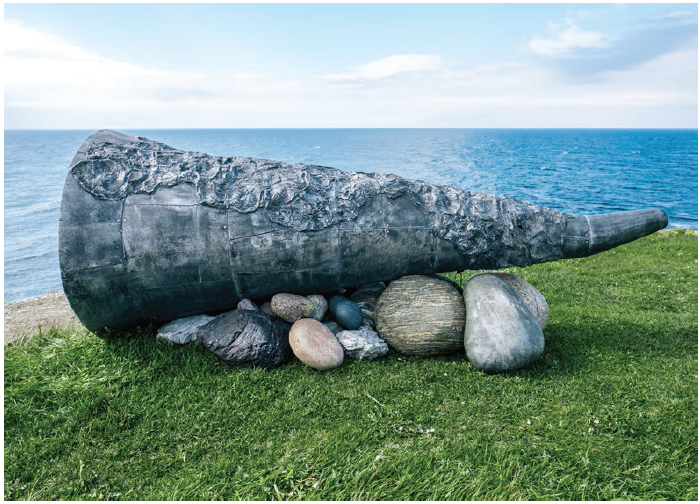
Figure 1. Rebecca Belmore, Wave Sound. Gros Morne National Park, 2017. Presented by LandMarks2017/Repères2017. (Photo courtesy of Kyra Kordoski and Rebecca Belmore)
Instruments of colonial measurement have played a central role in mapping an image of Indigenous lands as terra nullius. This false image of the empty wilderness—amplified and solidified not just through mapping but through the reified Canadian landscape-painting tradition of artists such as Tom Thomson, the Group of Seven,Footnote 3 Emily Carr, and David Milne—has, as observed by John O’Brian and Peter White, served both an “instrumental” and a “strongly sentimental role in the construction of Canadian identity” (2014:12). Pointed out across the shorelines of national parks, a riff on and rupture with telescopes and canons, the cones of Wave Sound critique this mythology of the so-called empty wilderness. As antimonuments, off-plinth and set on the ground, they lay colonial instruments of vacancy and “discovery” to rest. Nothing is acquired by these cones but moments in the life breath of the water and land, sounds which predate the technology and promise to outlast it. Rather than picturing the lands and waters as empty, Belmore’s structures point to the lands and waters as speakers (fig. 2).
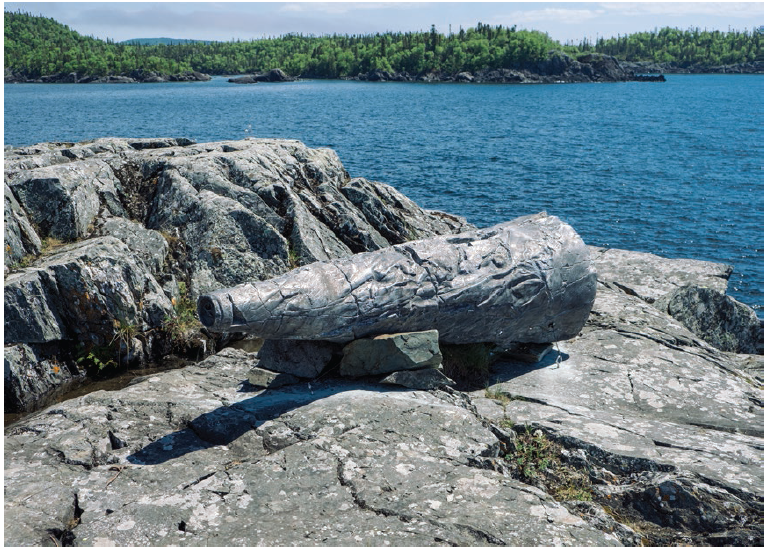
Figure 2. Rebecca Belmore, Wave Sound. Pukaskwa National Park, 2017. Presented by LandMarks2017/Repères2017. (Photo courtesy of Kyra Kordoski and Rebecca Belmore)
Belmore’s laying of her listening trumpets on national park coastlines invites a conversation on the scale of Du Bois’s “Great Near” ([1908-10?] 2015). This conversation is with the resilient living force of the water and land. Within the context of Canada’s settler-colonial history and present, it is a conversation that any person is already actively implicated in but may be largely unaware of, whether through inattention or prejudice. Writing about the work of Palestinian artists in relation to their own lands, Belmore’s frequent collaborator Anishinaabe-kwe artist and curator Wanda Nanibush writes, “The violence of borders and nations is ever present. But it is the land that tells another story, one harder to hear but ultimately more profound” (2016:106). With this observation by Nanibush in mind, the iterations of Wave Sound can be interpreted as prosthetics set down to amplify our ability to hear the vitality of the land on its own terms. This is an invitation to a new mode of relation with the land, beyond reinforcing the borderlines that parcel, divide, develop, and even allege to protect it.
Parklands as Stage
Wave Sound was commissioned by the Canadian not-for-profit organization Partners in Art as part of a series of artworks collectively entitled Landmarks/Repères 2017 on the 150th anniversary of Canadian Confederation.Footnote 4 Canadian parklands are central to the nation’s self-image. As Minister of the Environment, Tom McMillan wrote: “Parks are not a frill, peripheral to the Canadian experience. They are in its very marrow” (in Lothian Reference Lothian1987:5). The 2017 commission included 100 projects by 12 contemporary artists, displayed across 20 Canadian national parks.Footnote 5 Belmore’s decision to stage Wave Sound as part of a national commemoration across state-managed parks is politically charged. Canada’s national parks are historically imagined and marketed as sites of conservation, but, as such, their mythology imagines no preexisting custodians.Footnote 6 An intentional aspect of their settler-colonial function of enclosure is to disrupt Indigenous relationships to land in claiming it for the Crown, through what Eve Tuck and K. Wayne Yang have called the “particularized modes of control” inherent to “the biopolitical and geopolitical management of people, land, flora, and fauna, within the ‘domestic’ borders of the imperial nation” (2012:5). State-managed parklands introduce the state as mediator in anyone’s relationship with the land; once designated a park, anyone’s access to the land becomes subject to state permission.
It is no coincidence that, in Canada, the creation of First Nation reservations under the 1876 Indian Act and the 1885 establishment of the first national park in Banff, Alberta, occurred sequentially as part of a single settler-colonial logic. Rob Nixon has pointed out that “segregations of humans from nonhumans have long been implicated in the violent segregations of humans from humans.” Nixon writes that in relation to land “the noun ‘reserve’ may refer to either a sanctuary or a place of involuntary confinement—a refuge or a cage” (2011:175). Reservations designated land held “in trust” by the state for First Nations use and occupancy, while national parks designated lands for state management and regulated leisure activities, thereby cutting Indigenous communities off from the lands and waters on which they had moved freely, depended for sustenance, and of which they were the custodians.Footnote 7 National parks were designed to welcome tourists, not long-term relations.
The creation of national parks as sites of protection is historically tied to a perverse role reversal, in which colonialism and its aggressive claiming of lands “is made to look like self-defense” (Harney and Moten Reference Harney and Moten2013:17) or environmental protection. These projections of so-called Canadian land as both vast and in need of protection are key elements in what Tuck and Yang, after Janet Mawhinney (Reference Mawhinney1998), refer to as “settler moves to innocence” (2012:3)—a framework that naturalizes the occupation and regulation of the land. It was Thomas White, Canada’s then-minister of the interior, who was, not incidentally, responsible for managing the department of so-called Indian affairs and the department of natural resource extraction, who began legislative motions toward establishing Banff National Park. Despite claims from White that the settler state’s use of the parklands at Banff “commenced with a clean slate” (White [Reference White1885] 1887:84), the creation of this first national park in 1885 meant the displacement of at least six different First Nations, the expansion of the Canadian Pacific Railway, and increased westward extractive exploration for resources such as coal, copper, and lead. From Banff’s origins as a 26-square kilometer hot-spring reserve—it was the “virtues of the waters”Footnote 8 that attracted White in the first place—the growth of the Parks Canada system has been exponential, as today 450,000 square kilometers of land are designated as national parks by the federal government.
Waterways
Belmore’s four Wave Sound installations are site-specific. On the shoreline of Lake Minnewanka, in Banff, the silhouette of Wave Sound was made to mirror the shale of the surrounding land (fig. 3). At Pukaskwa National Park, an ear trumpet was cast in aluminum using a rubber latex imprint of a glacial crevice on Lake Superior found in the exposed granite bedrock of the Canadian Shield.
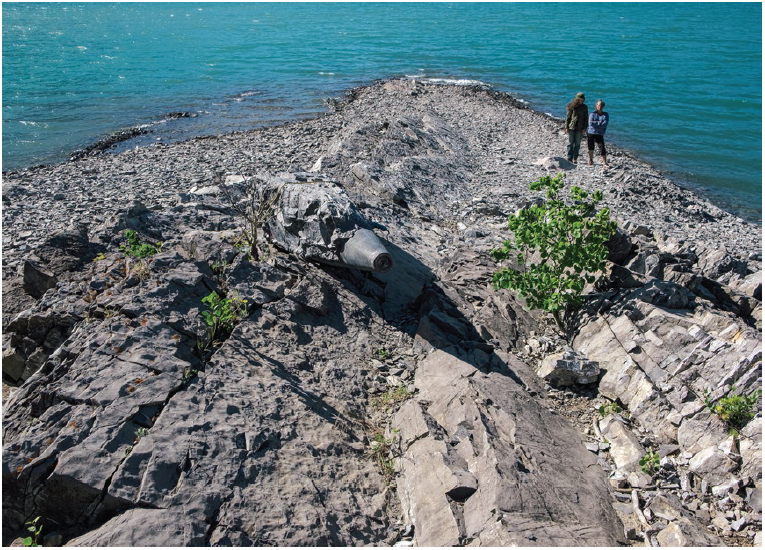
Figure 3. Rebecca Belmore, Wave Sound. Banff National Park, 2017. Presented by LandMarks2017/Repères2017. (Photo courtesy of Kyra Kordoski and Rebecca Belmore)
This Precambrian rock makes up almost 50 percent of Canada’s landmass, extending out from Hudson Bay in a horseshoe shape, across Quebec to Labrador, down to Lake Superior, across Manitoba, northern Saskatchewan, and northeast Alberta, and North into the Northwest Territories and Nunavut. In Gros Morne National Park, another aluminum trumpet taking the shape of the layered rock from the cliffs at Green Point was directed west into the Gulf of Saint Lawrence. The trumpet for Chimnissing Island in Georgian Bay, unlike the others—which were produced in collaboration with the Cuban artist Osvaldo Yero—was fabricated from pebbled copper sheets with FASTWÜRMS, the Canadian artist collective comprising Kim Kozzi and Dai Skuse (fig. 4). This copper cone shimmered among the sand and stones of the beach, resembling, while opening a blooming critique, of the colonial motif of the uncanny, lone, and obsolete canon pointed out at a body of water. Weighing only 49 lbs, this listening trumpet is significantly lighter than its aluminum counterparts (weighing 170–250 lbs each) and easy for two people to lift and move. During its installation on Georgian Bay, it was repeatedly raised and re-situated along the beach not to defend or define ground but to receive the sounds gliding over the waters of Lake Huron.
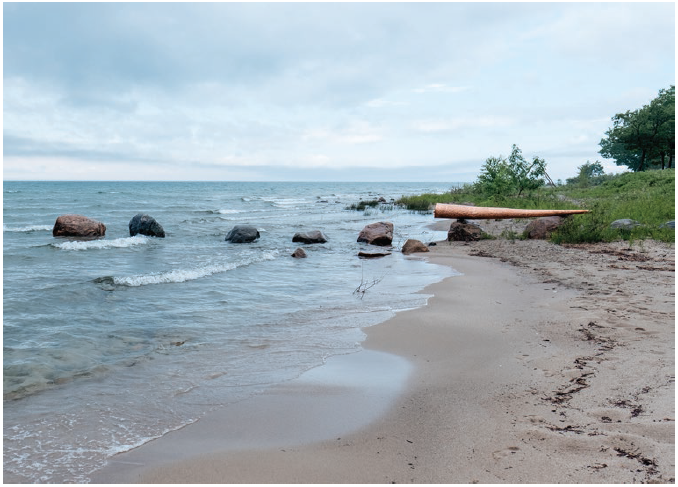
Figure 4. Rebecca Belmore, Wave Sound. Chimnissing Island, 2017. Presented by LandMarks2017/Repères2017. (Photo courtesy of Kyra Kordoski and Rebecca Belmore)
Belmore and FASTWÜRMS’s use of copper as material for Wave Sound at Chimnissing connects with the Anishinaabe peoples’ traditional use of copper vessels to collect and carry water. The formidable Anishinaabe-kwe water-rights activist Josephine Mandamin carried water in a copper pail while walking more than 17,000 miles along the shores of North America’s Great Lakes from 2003 to 2017, protecting the waters she held and circled, and raising awareness of water crises and the ongoing failure of both the United States and Canadian governments to provide clean drinking water to First Nations communities.Footnote 9
To date, Indigenous communities living on reservations within the borders of Canada are barred from managing their own water treatment systems. Legally, the federal government bears responsibility for providing clean drinking water and yet water protections on reservation lands have been historically and consistently flouted to pave way for development and resource extraction projects. The result is that many communities living directly on natural water basins are unable to fish and are dependent on bottled water. On Indigenous reservations in the United States 48% of households do not have access to clean water (Tanana, Combs, and Hoss Reference Tanana, Combs and Hoss2021) and, though Canada is home to the third-largest freshwater reserves in the world, a 2015 Canadian Broadcasting Company (CBC) investigation showed that two-thirds of all First Nations communities in Canada experienced at least one water advisory between 2004 and 2014 (Levasseur and Marcoux Reference Levasseur and Marcoux2015). The Chippewas of Nawash First Nation, located across from Chimnissing where Wave Sound was installed in Georgian Bay, have been under a long-term drinking water advisory since 2019. In several cases, the recovery of the water for household use is beyond boiling.Footnote 10
As a working-class white woman who has lived in England, Spain, the United States, the Netherlands, Colombia, and Canada, I have never experienced water contamination or scarcity, aside from some weeks in 2012 following superstorm Hurricane Sandy, which flooded my mother’s home. This research is conducted with awareness of the layered privileges held within my position, as UNESCO estimates 26% of the global population does not have access to safe drinking water, and this percentage is predicted to double by 2050 (UNESCO 2023). In the face of a global water crisis from contamination due to government negligence, conflict, draught, and rising sea levels, it is urgent to question why water is allowed to be commodified, and how water is imagined in different contexts, not only on the community or national level but also beyond borders.
The corralling of Canada’s waters has long been a focus in Belmore’s work. For Temple (1996), the artist filled Toronto’s Power Plant gallery with a structure made of more than 1,000 one-liter bags of water from Lake Ontario, Toronto’s Don River watercourse, and the gallery’s tap. The result is a murky yellow-brown composition with an offering at its center: a drinking fountain that dares you to take a sip. The cone shape turns up here as a small telescope at the top of a flight of stairs, next to the wall of water bags. Looking through the telescope, the lake outside comes in close, though ironically many viewers in the gallery assumed they were looking at video footage rather than the live landscape (Burgess Reference Burgess1999). As artist and scholar Marilyn Burgess has pointed out, Belmore’s art practice negotiates the mediation of nature in contained cultural spaces and “makes us think about how land is represented, exploring its mythic function in the circulation of colonial conceits” (1999:12). The artist confronts us with the ways in which the natural world is mediated and imagined within a settler-colonial society that has paradoxically reduced “nature” to a corporate dumping ground for the sake of resource extraction, while also portioning off sections as sites for aesthetic pleasure and apparently wholesome leisure.
In an interview with Burgess, Belmore asks, “How do we relate to our natural environment? How removed are we from acknowledging that we are part of nature? How great is that distance?” (13). The size of each Wave Sound listening trumpet visually suggests a vast distance between listener and sound, but, in use, their effect is one of intimacy. With her installation Fountain (2005), which premiered at the Venice Biennale, Belmore positions viewers before a video of the artist herself projected onto a cascading waterfall installed within the gallery. Belmore has said that the unpredictability of water in the gallery is central to the way the piece works. She states that: “water in the space becomes the performer and brings performance back into the edited video” (Belmore in Enright Reference Enright2005). But the climax of this piece comes when the artist breaks the fourth wall of the video, faces the camera/the viewer, and throws a bucket of water straight out, as if in their face—only here, the projected water turns bloodred. In Belmore’s work, the natural world—in this case water—is not a thing apart from cultural or artistic practice, but rather a physical presence alive and volatile within the gallery space.
Tuning in to the Unheeded
The curator of the 2017 Wave Sound installations, Kathleen Ritter, writes that what struck her from being on-site with the works was that
listening, much more so than looking, is about becoming aware, or more precisely, becoming attuned. Belmore’s work often uses sound as a site for an encounter, and here the act of listening becomes a slowing down of time and attention and awareness—an attunement with the land. (2018:84)
Through this attunement, we hear from the water, and may hear “the Great Near”: histories the water tells that are ongoing, unfolding, and intimate. Following Canadian historian Ian McKay’s suggestion that we reexamine Canada’s nationalist mythology, I would say that Belmore’s cones ask, alongside McKay, “What is continuous or discontinuous” in the history of these contested lands and waters? (1998:94). In Wave Sound, centuries of settler colonialism and abuse of the environment—and the water’s resistance and survival—are whirled into one quiet cacophony, a call.
Belmore’s centering of listening rather than looking is central to the decolonial function of these works. Writing on the ways we commonly use technology to amplify perception, Donna Haraway has pointed out that, historically,
The eyes have been used to signify a perverse capacity—honed to perfection in the history of science tied to militarism, capitalism, colonialism, and male supremacy—to distance the knowing subject from everybody and everything in the interests of unfettered power. (1991:189)
Privileging sight suggests a transparency within which the gaze is neutral and has clear access to everything it sees. This sensory relationship to the world has made possible what Macarena Gomez-Barris terms “the extractive view.” Belmore’s interventions, by contrast, offer another mode of perception of the land that is neither transparent nor extractive. Peggy Phelan writes,
How can one invent a pedagogy of disappearance and loss and not for acquisition and control? How can one teach the generative power of misunderstanding in a way that they will (almost) understand? (1993:173)
Wave Sound offers a visceral encounter with the sounds of the water and the land. It is an encounter through listening that is fleeting and never totalizing; the technology does not offer capture but rather a chance to practice another form of attention and relation.
Speaking about Belmore’s practice generally, Nanibush said to the artist in a recent interview: “You’re able to capture some kind of moment right before something transforms, or right before somebody breathes” (2020). Belmore’s ear trumpets seem to hold this potential energy. Rather than “giving a voice” to the natural world, the artist’s listening devices invite passersby to become aware of their own performance of perception, to stop and tune in to what is always already before them, to bodies of water as vital carriers of knowledge and news.Footnote 11 Heard that way, the water is not a resource for tourist visuality or industrial dumping or extraction practices.
In the parks, the “viewer” becomes the “listener” and must get down low to the ground, crouch on their knees or lie flat on their belly against grass, rock, and sand to engage these trumpets—a symbolic felling and prostration of the rückenfigur, the Western European romantic wanderer conquering a so-called sublime landscape. Belmore’s instruments do not only enable listening but also shift the listener’s physical orientation and affective relationship towards the ground they stand on before the water. As ethnomusicologist Kate Galloway describes of her experience of Wave Sound, to listen through these structures requires a “forced pause” (2020:182). The listener comes close and is made still while the waters remain in motion. The choreography prompted in this situation recalls Tina Campt’s observation that “sound can be listened to, and, in equally powerful ways, sound can be felt; it both touches and moves people” (2017:6).
For the shoreline of Lake Minnewanka, Belmore built a conical sculpture using a wax mold of the angular shale on which her listening trumpet eventually rested. Camouflaged on site, and unencumbered by much signage at the artist’s insistence, the first thing to strike the attention of a visitor to the park might be the imprint of an oversized human ear cast in aluminum poking out from the rock (fig. 5). If you crouched, you would see the curve of the antihelix, the slope of the tragus, and the opening of the ear’s canal. If you looked through it, you would not see the dark tunnel of an ear, but the lake water beyond in telescopic view. The ear, here, seals the narrow end of a 116”-long and 26”-wide cone. Like the titular character in Nikolai Gogol’s Nose, which leaves the face of Major Kovalyov and shows up in his barber’s morning bread ([1935] 2020), the human ear here is slippery. It has embedded itself in Belmore’s instrument, enticing us not to look but to press our own ear against it.
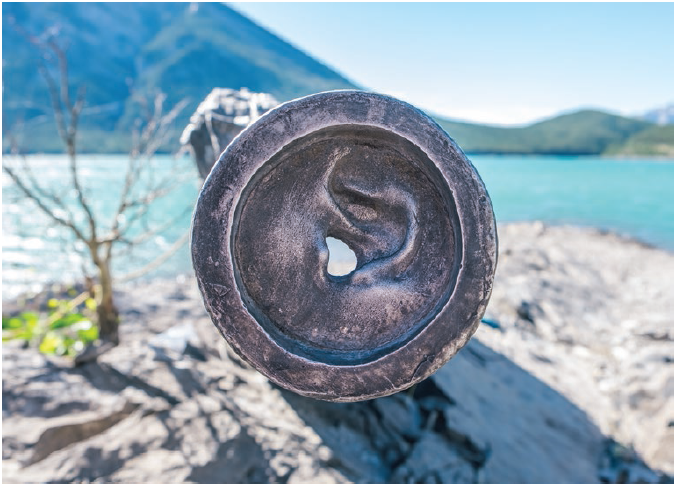
Figure 5. Rebecca Belmore, Wave Sound. Banff National Park, 2017. Presented by LandMarks2017/Repères2017. (Photo courtesy of Kyra Kordoski and Rebecca Belmore)
Jussi Parikka has observed that since the Renaissance and early modernity
new technologies of measurement from the compass to techniques of mapping were instrumental to the nomos of understanding and capturing global space, yet they were always bordering on and negotiating the problem of water, which remained more difficult to measure, map, and divide than land. (2016:136)
These sculptures do not intend to measure, contain, or map the sounds they carry from the water. Instead, they indicate that there is vital knowledge in “the problem of water.” Its constant movement means it always operates beyond the confines and capture of the mapped parklands. By not reducing, captioning, or translating the sounds of the water for the listener, Belmore’s mediation is one predicated on respect for opacity.
The Listener and the Land
Beyond the sound funneled through the instruments, the membranes of the cones are themselves a record of the furrows on which they sit. In 1919, mesmerized by the invention of the phonograph, Rainer Maria Rilke asked,
What variety of lines, then, occurring anywhere, could one not put under the needle and try out? Is there any contour that one could not, in a sense, complete in this way and then experience it, as it makes itself felt, thus transformed, in another field of sense? ([1919] 1999:41)
Rilke was imagining utilizing the phonograph needle to trace the coronal suture of a human skull, looking to convert the grooves it would necessarily find into sound, asking can we use the phonograph technology to amplify more primal sounds? In creating Wave Sound, Belmore casts her sculptures from the land they sit on to transcribe the lines formed by centuries of water on rock into her listening devices. She then turns each instrument back on its source, channeling the waterways that formed its grooves. Here sound is drawn in close rather than translated or transcribed, and listening depends on the listener’s response to the trumpet’s invitation.
Belmore told Lindsay Nixon that her aim with the project is “to ask people to sit on the rock and take a moment and just listen, to experience whatever they hear” (in Nixon Reference Nixon2017). Belmore gets us to listen to the sounds of the water itself—sounds that could be misidentified as ambient noise, the quiet, or even silence. Discussing John Cage’s view on silence, Marshall McLuhan writes: “All the things that are going on all the time in any environment, but things that were never programmed or intended—that is silence. The unheeded world is silence” (1967:6). The sound of the unheeded world is constantly mutable; and in that indeterminacy remains what Tavia Nyong’o calls “a threat to command and control” (2022:31).
The four cones of Wave Sound are not Belmore’s first use of the cone form to restructure the terms of who many speak and be heard and who may listen. In 1991 she created Ayum-ee-aawach Oomama-mowan: Speaking to Their Mother in response to the 1990 “Oka Crisis” and the Indigenous protest movement that rose to blockade the development of unceded Kanesatake (Mohawk) land 60 kilometers from Montreal—land not incidentally adjacent to the Kanesatake Reserve and the Oka National Park.Footnote 12 For this project, Belmore suspended a manufactured electrical megaphone within a larger plywood and animal-hide cone (seven-foot-long and six-foot-wide at the mouth), which she built in Banff with local carpenters Mimo Maeola and Bob Knowlden and installed in a meadow in Banff National Park. In 1992 the artist traveled with the device to First Nations communities across Canada, on reserve land, in towns, cities, and at an active logging blockade. Belmore has described that, although her initial impulse was to shatter the windows of Parliament Hill (Beaucage Reference Beaucage1992), she shifted her attention away from the politicians and corporations whom we have come to expect as the recipients of protest; instead, the device was used to speak to the land. As Jessica L. Horton points out, Belmore’s creation “transformed a technology of modern manufacture and authority into a conduit for connecting a variety of human and other-than-human speakers and addressees” (2017:58). Speaking through it, one’s voice would be amplified and might echo back, as Belmore recounts in her experience of first speaking into it in Banff: “It echoed off the mountains and all over the place and it was my voice, I could hear my voice way over there separated from my body and bouncing off and echoing off mother earth, the land” (in Beaucage Reference Beaucage1992). In an interview with Naninbush, Belmore describes Ayum-ee-aawach Oomama-mowan as both poetic and political: “Poetic because we were speaking directly to the land. Political because of the long history of others working to silence the sound of our voice echoing off of this land” (in Nanibush Reference Nanibush2014:214–15).
Speaking into the narrow end of a cone is a more familiar gesture than pressing your ear against it. One is an iconic symbol of protest; the other is not. In asking us to sit or lay down on the ground and use the technology to listen to ambient noise, with Wave Sound Belmore reconfigures our relation to the land and the water, but also to witnessing performance. This is a radical act in that, as Nanibush writes, “All structures and modes of containing humanity are challenged when thinking of the human in relation to the land” (2016:106). The megaphone shape signals a speech act at work, but here the speaker and technology are flipped. Rather than amplify human speech, the cones of Wave Sound call on humans to listen, not to the artist but to the land itself. Through their installation in national parks, both Ayum-ee-aawach Oomama-mowan and Wave Sound suggest conversations between human beings and the land that are beyond state control or mediation.
Listening to soundwaves from the land and water is a powerful tool in resource extraction; seismic echosounders are used in deep-sea mining for minerals and in discovering oil and gas beneath the seafloor. Such technology is a crude example of what Dylan Robinson describes as “Hungry Listening,” a mode of perception that “prioritizes the capture and certainty of information over the affective feel, timbre, touch, and texture of sound” (2020:38). Belmore positions her listener in a nonacquisitive role, to perform what Robinson describes as
a listening that does not reduce what is heard to the knowable, that resists a multicultural categorization of one cultural sound among many, that understands sound in its irreducible alterity, and that moves beyond our recognition of normative musical or performance protocols. (2020:64)
A settler-colonial worldview that imagines human sovereignty over nature is contested, as Wave Sound refuses extractivist listening by positioning the listener in an embodied relation to the land—one in which the human is made to sit directly on the ground and listen without the aim of grasping something in particular.Footnote 13
Unlike the mechanical and easily portable megaphone structure of Speaking to Their Mother, Wave Sound’s mimicking of shale, glacial crevices, and cracks in rock imbues these cones with a sense of geological time and wear. “Being tied to the land also means being tied to an unwritten, unseen history of resistance,” Leanne Betasamosake Simpson writes (2021:173). Belmore does not tie the listeners to the land, but to use these cones does require that you alter your orientation and drop down close to it. It could be argued that the cone’s size serves to shrink its user. Most instruments allow us to pick them up, while this one requires us to get down low and come to it (fig. 6). As a tool intended to retune how we listen to and relate to the world around us, the instruments of Wave Sound are not ends in themselves. Tools are used to build things and take them apart. In this case what is being dismantled are our projections onto the land, and what is being built is a willingness to reorient, to hear what it has to say.
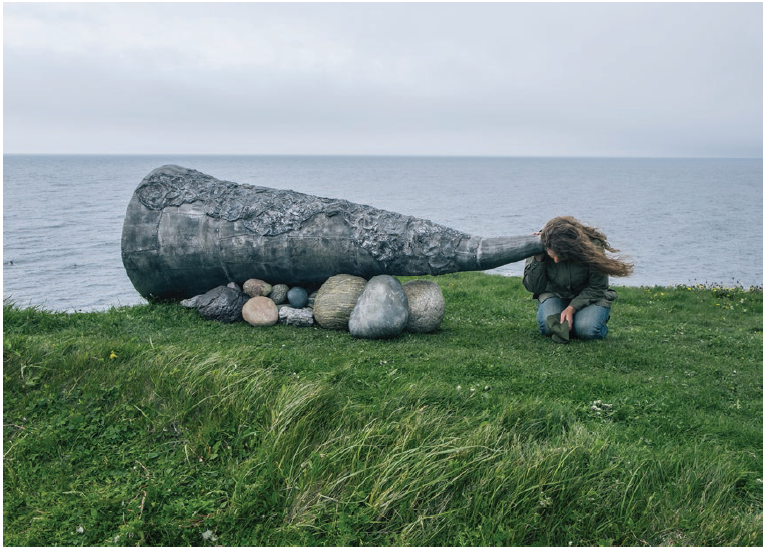
Figure 6. Rebecca Belmore, Wave Sound. Gros Morne National Park, 2017. Presented by LandMarks2017/Repères2017. (Photo courtesy of Kyra Kordoski and Rebecca Belmore)
In Du Bois’s “The Princess Steel” the one catch to the sociologist’s megascope technology is that not everyone sees the same thing when looking through it. Tuned in, the man of the white sociologist couple is transported to Pittsburgh, given sight of an epic battle over an African princess, whose steel hair is spun for profit and sold in curls from Chicago to San Francisco. But when he puts the technology down and turns to his wife, she remains unmoved having seen nothing but New York City’s streets below in real time. “Didn’t you see—didn’t you hear?” he asks. “I’ve been watching Broadway,” she says, exasperated. “Did you not hear the roar of the waters?” he says, to which she replies, “I heard the roar of passing wagons and the voices of men.” She isn’t transported through visions of colonial exploitation and industrial expansion, because, as the sociologist offers, the technology is “not tuned delicately enough for her” ([1908–10?] 2015:829). The same risk holds in Belmore’s cones.
Unlike the megaphone of Speaking to Their Mother, which is singular and was conceived for Indigenous communities to use with the guidance of Belmore herself, the cones of Wave Sound were made available to all passersby—a technology offered with neither instruction nor explanation. The result of an individual pressing their ear to a listening trumpet might range from familiarity to dismissal, to disorientation, to an epistemic shift. The trumpets of Wave Sound serve as physical markers for a conversation that is ongoing, polyvocal, and only ever partially accessible (fig. 7).

Figure 7. Rebecca Belmore, Wave Sound. Chimnissing Island, 2017. Presented by LandMarks2017/Repères2017. (Photo courtesy of Kyra Kordoski and Rebecca Belmore)
The Gallery
The Wave Sound trumpets have since been airlifted from Canada’s national parks to be exhibited in galleries, notably within Belmore’s traveling retrospective Facing the Monumental (2018), where they were laid on floors at the Art Gallery of Ontario in Toronto, The Musée d’art contemporain de Montréal, and Remai Modern in Saskatoon, as well as in the Landmarks/Repères 2017 survey show A Sense of Site (2019) at the Art Gallery of Nova Scotia. Where their jagged surfaces helped them blend in on the parklands, they now stood in rough contrast with the flat floors. Recorded sounds from the original locations of the aluminum trumpets were installed for some iterations of the exhibition, through headphones or broadcast into the gallery space, and these recordings remain available online. They were taken with the help of photographer Kyra Kordoski, who placed a small Zoom recorder within the shell of each sculpture. These recordings project water and wind pounding a shoreline at Lake Minnewanka in Banff; a rush of saltwater at Green Point’s seaside cliffs in Gros Morne National Park; and competing sounds of gentle currents, birdsong, and what might be a distant whirr from the Trans-Canada Highway near Pukaskwa National Park. Listening, whether live in a park or to a recording in a gallery, is a durational experience that cannot be skimmed the way the surface of an object or a painting can be.
In the white cube of the gallery space, the Wave Sound instruments do not funnel water and wind, but gallery grounds are no more neutral or ahistorical containers than national parks. Wave Sound asks that we consider our relationship to the gallery space and to the land beyond its walls. The three aluminum cones have been acquired by the McMichael Canadian Art Collection in Kleinburg, Ontario (fig. 8). Founded by Robert and Signe McMichael in 1952, the gallery is the only major museum in Canada devoted exclusively to Canadian art. It holds a near-mythical place in the history of Canadian landscape representation and refers to itself online as the “spiritual home to the Group of Seven” (McMichael Canadian Art Collection 2020). Known for their depictions of a vast and rugged wilderness, the works of the group, active between 1920–1933, are considered both a national treasure and a major buttress within a settler-colonial mythology that has historically cast Canadian land as empty and the Indigenous population as absent. The McMichael’s collection not only grew from personal connections to members of the group, but also from what Robert McMichael himself called a singular “obsession” for collecting and presenting their work (1986). The gallery property is the physical burial grounds for six of the Group of Seven members and is home to the tool shed in which Tom Thomson made many of the paintings that inspired them. The collection’s founders went so far as to argue that the McMichael should serve as a permanent “memorial to a particular period of Canadian art” (McMichael v. Ontario 1997).
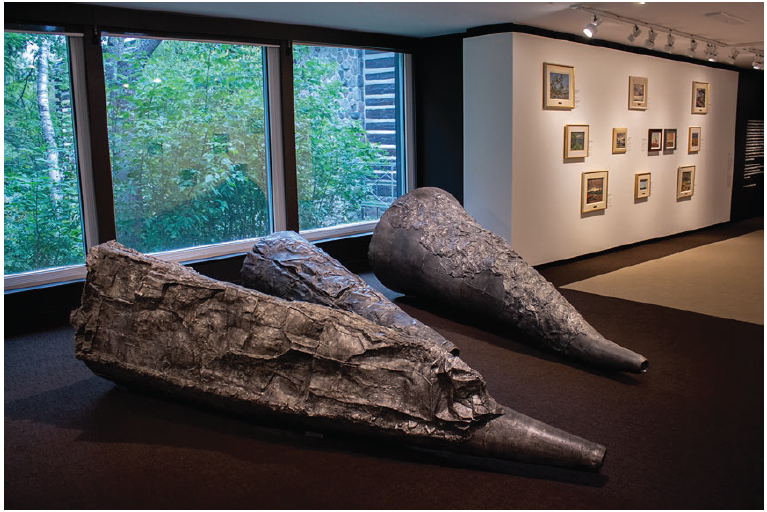
Figure 8. Rebecca Belmore, Wave Sound at the McMichael Canadian Art Collection, 2017. Presented by LandMarks2017/Repères2017. (Photo courtesy of Kyra Kordoski and Rebecca Belmore)
In 1965, the stewardship of the collection, the gallery building, and the woodlands surrounding it were taken over by the Province of Ontario. Decades of tension over the addition of more contemporary work to the galleries culminated in a 1997 lawsuit against the government, during which McMichael argued the space “[…] was never intended to be a gallery in the sense of, ‘Come one, come all, we’ll hang all these different kinds of new work as it comes along’ and so on” (McMichael v. Ontario 1997). Though the McMichaels did win the lifelong right to directly participate in the acquisitions and deaccessioning decision process of the gallery, both Signe and Robert are since deceased. The institution has refashioned itself as home to a wider concept of what constitutes an intrinsically “Canadian” artwork. They have in recent years increased their acquisitions of works in different media and have acquired many more works by contemporary Indigenous artists. It is here, back on a different parcel of protected crown land, in a collection designed around the paintings of the Group of Seven and the works of Tom Thomson, that Belmore’s sculptures now face out a floor-to-ceiling window toward the Humber Valley and River (fig. 8).
In an article in the Toronto Star, Chris Hampton rightfully highlights the contrast between Belmore’s listening trumpets and the surrounding plein air sketches by Thomson and the Group (2022). The sketches imagine the wandering visual study as the pinnacle of artistic attunement to the land, while Belmore’s technology asks us to interrogate what is perceivable beyond what we choose to see and points to the land itself as a speaker overlooked. As Nanibush has written in response to Belmore’s 2022 The Sound of the Colour Field performance at the Venice Biennial, “the one thing that can never be produced in a painting that can in a performance is sound” (2023:29). In the gallery, Belmore’s listening devices signal there are more ways to perceive than those most often privileged and reinforced in such places.
Hampton compares the enormity of the Wave Sound cones to “dinosaur bones” (2022), and here I believe he imposes a false temporal limitation on them. Though they are no longer at the sites that inspired them, these oversized listening devices do not belong to another era; this is neither a foreclosed technology nor one designed for obsolescence. Unlike a bone whose functionality depends on being set in place, Belmore’s listening trumpets are adaptable tools. As with Belmore’s use of the Power Plant Gallery’s own water supply in her 1996 installation of Temple, for which she used outside water from the Don River and Lake Ontario together with the gallery’s own tap water, here Wave Sound encourages us to tap into the layered history of the gallery site itself. The listening trumpets disrupt a vision of the art world as a sterile space apart from the world outside. Just because they are currently indoors does not mean that they will always be, or that the land on which they now sit is any less worthy of attention. They continue to invite us to tune in to narratives that might be at play beneath the gallery space and on the unceded land that surrounds it. They ask us as visitors to acknowledge and interrogate our environment beyond what is immediately visible and to consider our own ongoing relationship with the ever-shifting ground on which we stand.










